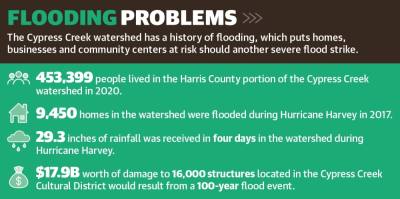“The creation of the special district would enable us to seek state funding and federal funding for flood control efforts,” said Glenn Wilkerson, president of the Cypress Creek Flooding Task Force, a Spring-area organization made up of community leaders. “Right now, we have no voice to help us do that, so the creation of this district is desperately needed.”
The Cypress Creek watershed has a history of flooding with 29.3 inches of rainfall received and 9,450 homes flooded during Hurricane Harvey in 2017, according to the Harris County Flood Control District. Flooding events such as Harvey have sparked efforts to mitigate flooding, such as the task force’s proposed drainage district. Since the communities along Cypress Creek are largely within unincorporated Harris County, there is no central government entity to assist with these funding efforts.
The district would be led by a board of directors who would decide what flood mitigation efforts to pursue along the Cypress Creek watershed, Wilkerson said. Before the district can be created, however, it must be filed in a bill proposed by a local legislator. The task force has been working with state Rep. Sam Harless, R-Spring, to file the legislation to create the drainage district.
"I certainly am interested in [the drainage district], but I want to make sure that there’s not a tax increase on my constituents or that there’s not a bond proposed,” Harless said Nov. 23.
As of press time Jan. 11, Harless had not yet filed the bill. March 10 is the deadline for legislation to be filed for the ongoing legislative session, which began Jan. 10 and will end May 29.
Moving toward change
If the legislation to create the task force’s drainage district is filed and passed by the Texas Legislature, the bill would go before Gov. Greg Abbott for approval in June.
The bill would create a temporary board of directors for the district, Wilkerson said. The temporary board would then call a districtwide election as soon as November for the community to vote on a permanent board of directors and “confirm the creation of the special district,” he added.
The task force’s initial plan was to have a local legislator file a bill directly giving the drainage district taxation powers if approved by voters in an election. However, this idea has since been scrapped, Wilkerson said.
“The purpose of the legislation the task force is proposing is to create a special district and a board,” Wilkerson said. “The special district created by the bill will have no taxation powers nor powers of eminent domain.”
If voters eventually approve the district in an election, the district’s permanent board of directors would discuss and establish a funding mechanism for the district, he said. The district could pursue projects to mitigate flooding along Cypress Creek, look into state and federal funding for flood projects, and develop partnerships with local utility districts.
The Cypress Creek Flooding Task Force—which formed in 2019, according to Wilkerson—initially announced the proposed Cypress Creek drainage district in May. The group set out to create the district to prevent catastrophic flooding to homes and structures in the watershed, including the Cypress Creek Cultural District, which is home to community amenities, such as the Barbara Bush Branch Library, The Centrum, the Pearl Fincher Museum of Fine Arts and the future George H.W. Bush Community Center, which is under construction.
According to the task force’s estimates, $17.9 billion worth of damage to 16,000 structures located in the Cypress Creek Cultural District would be caused by a 100-year flooding event—or an intense flood that has a 1% chance of occurring yearly.
Community group reactions
Since proposing the drainage district, the task force has met with other local organizations that fight flooding in the Cypress Creek area. Multiple members of the Cypress Creek Flood Control Coalition—a nonprofit founded in 1999—joined a steering committee with the task force in late July to discuss the proposed drainage district, CCFCC President Joe Meyers said. Since then, the task force has presented drafts of legislation to the steering committee.
“[CCFCC] did pass a resolution in support of efforts [of] like-minded efforts to solve flooding,” Meyers said. “That includes supporting, corroborating, cooperating and coordinating with like-minded efforts in the creation of a drainage improvement district for Cypress Creek. So we agreed that this was something worth being in the mix with versus outside.”
Cypress Creek Association-Stop the Flooding also works on flood mitigation efforts in the Cypress Creek area. The organization’s founder, Paul Eschenfelder, said he wished the task force would hold public meetings with the community about the district, and he worries the proposed district is not the right solution for local flooding problems.
“A special-purpose district will be required, but a better version than the one currently proposed, which leaves the Cypress Creek Cultural District exposed to repeated flooding,” Eschenfelder said.
In the 88th legislative session, the Houston Northwest Chamber of Commerce supports Texas legislators generally addressing flood mitigation along Cypress Creek, President and CEO Bobby Lieb said. However, the chamber does not have a position on the proposed drainage district.
“The chamber has taken official positions on working and advocating towards flood mitigation in/along Cypress Creek and the Greater Houston area,” Lieb said.
When it comes to funding and attention, Meyers said he believes the Cypress Creek watershed has been “historically neglected” compared to other watersheds in Harris County.
“Cypress Creek ... just hasn’t gotten the funding and the support that other watersheds have gotten for a lot of different reasons,” Meyers said. “Now ... Cypress Creek is the largest watershed. It’s got a 10th of the population in Harris County, and it’s growing, and it still has a lot of area to grow.”







